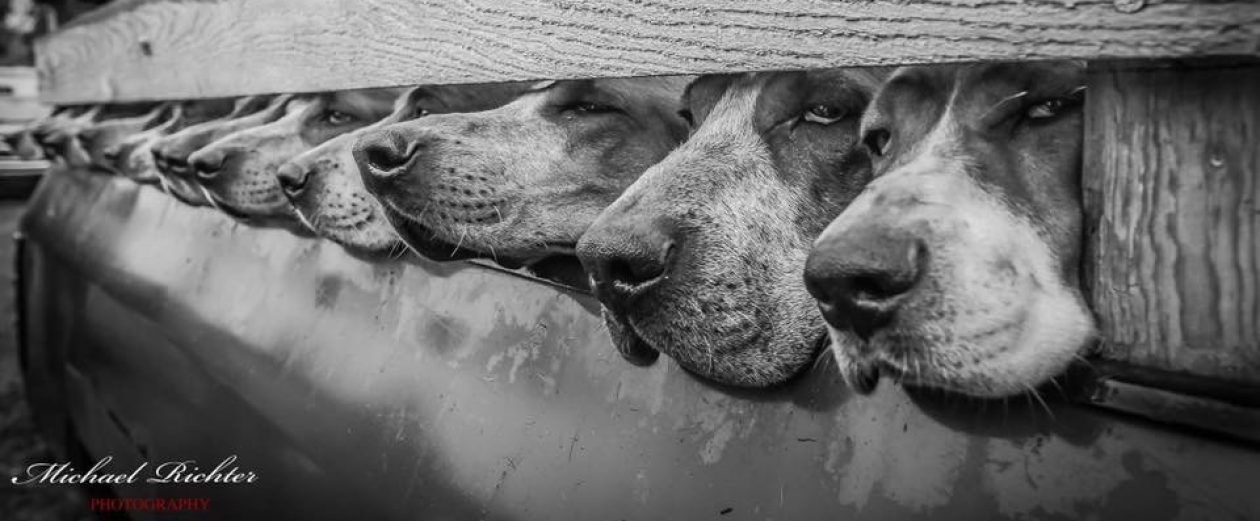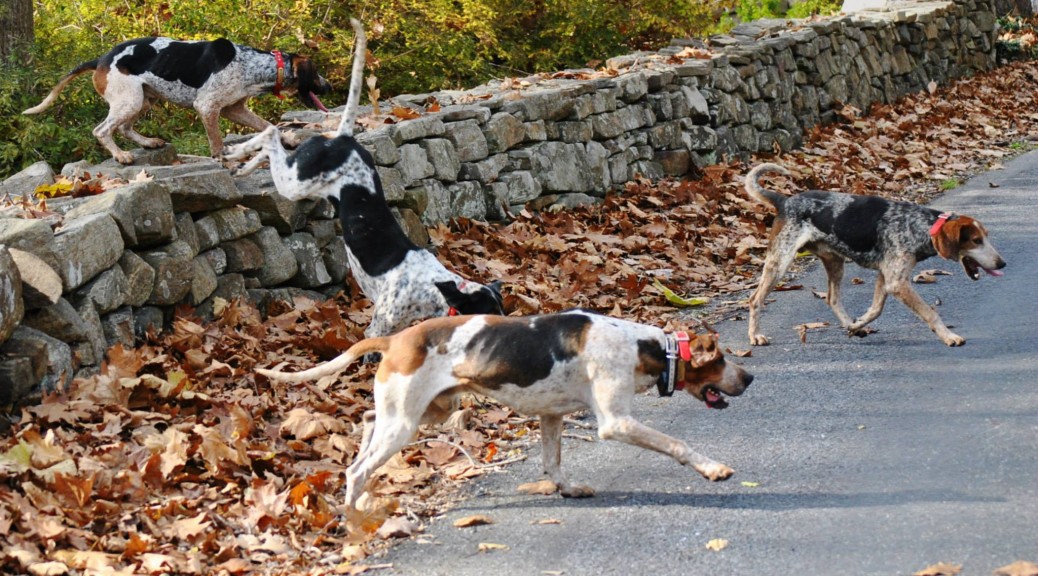What is foxhunting?
Foxhunting is the pursuit of wild foxes, red or gray, with hounds whose keen sense of smell enables them to follow the trail left by their quarry. When hounds are on the trail, they give voice, which enables the followers to tell by hearing, what the hounds are doing, if they cannot see them. The people following the hunt do so on horseback, by car or truck, and sometimes on foot.
What do you do when you catch the fox?
We do not catch the fox. The object is to chase him until he goes to ground (down his hole, or earth) and then to look for another fox to chase.
I’m a little confused. If you don’t want to catch the fox, why chase him?
That’s a good question. We do it because we like to get outside in the countryside. We like to watch the hounds try to find the line of the fox and work it out. We love to hear hound music. We like the uncertainty of whether we will find a fox, and if we do, where he will lead us. We hope to catch a glimpse of him. (View him) We enjoy galloping around and getting covered with mud, soaked by rain or sweat, depending on the weather, slashed by brambles, whacked by tree limbs and other such thrills. We love to ride until our legs feel like jelly. We love the partnership between horse and rider that this sport requires. And, if we don’t find a fox, and spend the day standing around, we still are satisfied by being outside and trying. We like spending time with our friends. And we have great parties afterwards where we tell lies about what we did.
Isn’t the object to kill the fox?
No, not in America. If we kill him, we can’t chase him the next week. We want to have a healthy fox population.
Do foxes in America have natural enemies?
Yes. Man, of course. They are trapped for their fur. Many farmers mistakenly think that foxes are harmful and prey on their poultry. However, foxes are actually beneficial because they feed primarily on small rodents which would otherwise eat crop roots, seeds and grain. Nowadays, commercial poultry is raised in houses and is not at risk from a fox. One natural enemy is the coyote, which is expanding its range and will drive out the foxes, or drive them into more built up areas. Disease also limits the fox population. When foxes become too numerous, they tend to develop and spread mange, which makes their hair fall out and they die of hypothermia. Automobiles also account for a majority of the deaths of foxes each year.
So foxhunters actually encourage more foxes?
Yes. Foxhunters are very much concerned with conservation of foxes and a healthy balance of species of all wild animals. In Pennsylvania, it was foxhunters who lobbied for years first to have the bounty removed from foxes, and then to have it declared a fur-bearing animal with a closed season. Prior to that, anyone could shoot or trap foxes with impunity. Foxhunters in many other states have lobbied for similar legislation. You will find that areas where the fox is “hunted” with hounds will have more foxes, due to the efforts of the foxhunters.
Do you ever kill the fox?
Very rarely. Usually when a fox gets killed, it was a sick or mangy one, or one that made an incredibly stupid mistake.
Do you ever drop a fox?
No. Dropping a fox (letting loose a caged fox for the hounds to chase) is not only unsporting, but illegal.
What does the fox think about all this?
If the fox doesn’t want to be chased, he goes to ground. However, if the fox keeps running, even though there are handy holes nearby, we can assume that he isn’t tired of being chased. We have seen a fox sit down and watch the hounds and wait for them, and then continue on.
What if the hounds see the fox?
A hound follows his nose. A fox can be within several yards of a hound, but if the hound doesn’t scent him, he will ignore him. A fox is aware of the wind so he knows how close he can come without the hounds scenting him.
How does the fox get away from the hounds?
Foxes are extremely clever. They know how their scent will lie and will walk over dry leaves or dry grass where the scent won’t stick. They will go up a creek, so the water washes away the scent. They will backtrack and circle or walk along the top of a fence or a wall to throw the hounds off. They will use the scent of other animals to obscure their own. They have been seen to run through sheep or cattle pens or follow a manure spreader. In Pennsylvania, where we have numerous deer, they often run right through a group of deer to confuse the hounds. Gray foxes also climb trees.
What’s the difference between a red and a gray fox?
Besides color, they are different species. The red fox, vulpes fulva, is a bright russet color, with a white tag on its tail, white chest and black legs. It was originally native to Canada and the Northern states, but did not occur in the South. Foxhunters in Virginia imported red foxes from England in the eighteenth century. They gradually spread Southward and Westward. The red fox will run in a large loop, several miles in diameter and usually return to where it was started. For this reason, it is more fun to chase than the gray fox, Urocyon Cineroargenius. The gray fox lives in denser cover, thickets, briar patches and marshes. It runs in very small circles and does not like to take off across open country. The gray fox is an accomplished tree climber.
Do you ever dig out a fox?
No. We feel that if a fox goes to ground, he doesn’t want to be chased any more. We will then either call it a day, or find another fox to chase.
Do you ever chase anything besides foxes?
Hounds will not make a distinction between fox and coyote, so if there are coyotes in the area, they will get chased. However, coyotes are very, very fast and are hardly ever caught. In the South, where bobcats are numerous, the hounds sometimes chase them.
What about deer?
Originally, the object of hunting by the nobility was to chase deer. The staghounds would bring the stag (the male of the red deer, similar to our elk) to bay; then the huntsman would dismount and kill the stag with a knife (very dangerous) then take it home for the lord’s table. The common people, farmers and tradesmen, would chase hares with harriers, a smaller breed of hound. By the time of the eighteenth century, deer had became scarce, while foxes had become numerous and were a nuisance, so the whole tradition continued with the fox as the quarry. Today in America, deer are very much a problem for some packs. The hounds must be trained assiduously to ignore the scent of deer and to run fox only. In Virginia, it is legal to chase deer with hounds, for the hunters to shoot.
What is a drag?
In countries that are too built up for hunting, an artificial trail of scent will be laid down for the hounds to follow. It should simulate the trail of a fox, and not be laid as a steeplechase. In this way, the hunt will go only where it is welcome, and hounds will not be endangered by traffic. It is not as good as live hunting, but for some countries, it is the only thing possible.
Who can go foxhunting? Isn’t it for the uppercrust?
Foxhunters come from all walks of life. Most hunts welcome anyone who is courteous, pays his or her subscription promptly, and is willing to help out.
How much does it cost?
Hunts vary widely in their subscription or membership fees. A hunt with a clubhouse and paid staff will cost a good deal more than one with honorary staff. If you can afford to keep a horse and pay your hunt subscription, there is probably a hunt for you somewhere. If you can’t afford to keep a horse, you can follow a hunt by car. Some hunts have a social membership at a reduced price for non-riders. Capping fees (the fee a guest pays for the day) can vary from less than $20 to $150 or more. And, if you own the land over which they hunt, you don’t need to pay anything.
What kind of a horse do I need?
Many different breeds are successful hunters. The horse has to be quiet and sensible, stand quietly, not kick other horses or hounds, and make his way across country safely. He must not panic in mud or underbrush. Some horses are more suited to one country than another. For example, in a wide open country, the horse needs to be faster. If it is very rocky and hilly, you need a smaller, more nimble horse.
Does my horse need to be a wonderful jumper to foxhunt?
It depends on the country. If there are big jumps and no way to get around them, then the horse must be able to safely negotiate them. In some countries, there are few jumps, or only logs across the trail. Some countries have alternate routes for non-jumpers.
How do I get invited to hunt?
If you have a friend who hunts, ask him or her. All hunts that are recognized by the Masters of Foxhounds Association are listed on this map. You can find MFHA on Facebook.
What kind of dogs do you use?
Foxhounds are used to chase foxes. The foxhound is a scent hound. It has a very good nose and will follow the trail of its quarry. All male (dog) foxhounds stand between 22 and 25 inches high at the shoulder and weight between 50 and 80 pounds. The females (bitches) are smaller, standing between 21 and 24 inches high and weighing between 40 and 65 pounds. They come in all colors: white, red, black and tan, tricolor (black tan & white), blue tick, red tick, black and white, tan and white, etc. They are naturally gentle and affectionate, but all they live for is hunting. They are bred for the following characteristics: Nose (scenting ability), Cry (or voice), Fox-sense, Drive, Steadiness, Obedience (biddable or tractable), Soundness, Way of Moving, Stamina, and Conformation.
There are several different strains of foxhounds. Field Trial strains do not hunt in a pack. These include the Walker, July and Trigg, so named after the men who developed them. They are used for night hunting and field trials. Pack hound strains hunt cooperatively as a pack and are used for following on horseback. They include English, American, Crossbred and Penn-MaryDel.

